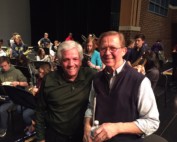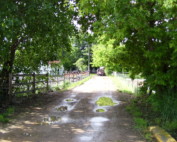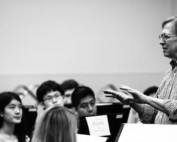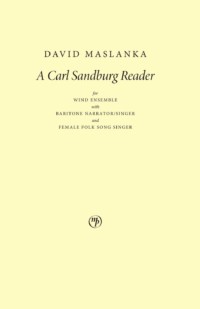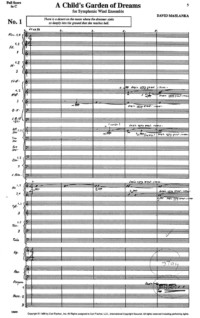Project Description
Wind Ensemble
1991
49 min.
Listen Now
The University Of Connecticut Symphonic Wind Ensemble, Gary Green, cond.
On the album Wind Band Classics – Reflections (2007)
Preview Score
Instrumentation
Picc-2 Fl-2 Ob-2 EH EbCl BbCl-3 BCl CbCl Bsn-2 Cbsn ASx-2 TSx BSx | Hn-4 Tpt-3 Tbn-3 BTbn Euph Tuba DB | Pno Timp Perc-4
- Piccolo (2)
- Flute (2)
- Oboe (2)
- English Horn
- Clarinet in E♭
- Clarinet in B♭ (3)
- Bass Clarinet in B♭
- Contrabass Clarinet in B♭
- Bassoon (2)
- Contrabassoon
- Alto Saxophone (2)
- Tenor Saxophone
- Baritone Saxophone
- Horn in F (4)
- Trumpet in B♭ (3)
- Trombone (3)
- Bass Trombone
- Euphonium
- Tuba
- Double Bass
- Piano
- Timpani
- Required Percussion (4 players)
- Xylophone
- Glockenspiel
- Marimba
- Chimes
- Triangle (3)
- Vibraphone
- Bongo
- Snare Drum
- Tenor Drum
- Tambourine
- Suspended Cymbal (1 sm., 1 lg.)
- Tam-tam (lg.)
- Sizzle Cymbal
- Gong (5) (asst. sm. to lg.)
- Crotales (chromatic set plus A&B on fixed rack to be bowed)
- Anvil
- Tom-toms (2)
- Bass Drum (2) (1 with attached crash cymbal)
- Wood Block
Movements
- Moderate ♩= 84-90
- ♩= ca. 72
- Very fast ♩= ca. 180
- Lament ♩= ca. 86
- Lament ♩= ca. 78 (“Song for a Summer Day”)
Commissioned by
Commissioned by, and dedicated to, the University of Connecticut (Storrs) Wind Ensemble, Gary Green, conductor. The commission was funded by the Research Foundation of the University of Connecticut.
Premiere
Completed
8 May 1991, Missoula, Montana
Program Note
Symphony No. 3 was commissioned by the University of Connecticut Wind Ensemble, Gary Green, conductor. I was asked to write a “major” pice yet not necessarily one as big as this. It is hard to say why a given music emerges at a given time. In my composing life there have been “sign-post” pieces – large works that have erupted at fairly regular, though unpredictable, intervals. The impetus for this piece was in part my leaving university life a year ago and moving from New York City to the Rocky Mountains of western Montana. The mountains and the sky are a living presence. Animal and Indian spirits still echo strongly in this land, and these elements have found their way into my music.
I am very grateful to Gary Green and the University of Connecticut for sponsoring the composition of Symphony No. 3. I am especially thankful to Gary for his ardent championing of my work in recent years, and for his avid interest in the development of this new piece. His wonderful enthusiasm has sparked the creative process in a special way.
Symphony No. 3 is in five movements and runs approximately 45 minutes. The first movement is in a moderate tempo and follows one of my favorite schemes. It starts with the simplest of scale materials and evolves a steady, unbroken line from start to finish. It is in sonata form, tightly woven in character, giving it something of a Baroque feel. The movement is forceful and unrelenting for most of its duration, but ends quietly.
The second movement is a serene and beautiful “nature” music, mostly for small combinations of instruments. I am intrigued with the magical quality of sustained pure colors. Musical sound is colorful and structural at t he same time. I love a music that allows the listener to develop an intense reverie through sustained sounds, while at the same time being carried through the structure of the piece. Time and timelessness join in a powerful way, each informing and illuminating the other.
The third is a fierce and bristling fast movement that maintains its high energy from start to finish. It is also in sonata form. The development section is a fugue which rises in power to a huge climax area. The music is fixed largely in the tonality of A minor: the first and second themes are in A minor, a third theme is in D, but the exposition ends in A minor. The development begins and ends in the home key, as does the recapitulation. This unmoving tonal scheme emerged and would not be derailed, so I had to let it happen. The tonal fixation seems to underline the character of fierce power.
The fourth and fifth movements are both lamentations, though not particularly slow or “down” in spirit. It is hard to describe opposites existing in the same space and time. The music is joyous yet sorrowful, recognizing the complementary nature of life and death. These movements – indeed the entire Symphony – have grown out of my perceptions of natural forces, especially the strong currents of old life that exist here in Montana. The music is a lamentation for the loss of the old direct contact with the life of the Earth, yet a recognition that these value still exist and can be brought back into meaningful focus.
The fourth movement does not have an easily-labeled traditional form. The music moves through a series of song-like episodes, much as one might move through mountain meadows and across hills, natural vistas of great beauty appearing and dissolving as one goes. About two-thirds of the way through is the song of the “Golden Light”
The fifth movement might be called “Song for a Summer Day.” The character of lament is there, but the creative winds rise and bring an ecstatic vision of natural beauty and life force. The movement ends with the lament transformed into a song of quiet joy.
Further Reading
From the Maslanka Archive – No. 34, Julian Velasco’s Interview of Gary Green
From the Maslanka Archive features media and stories of David's life and work. This week, we are excited to feature Julian Velasco's interview of Gary Green from the Wharton Center in East Lansing, MI from October 24, 2017.
From the Maslanka Archive – No. 32, Julian Velasco’s Interview of David – Part 2
From the Maslanka Archive features media and stories of David's life and work. This week, we are excited to feature Part 2 of Julian Velasco's interview of David from his home in Missoula, MT in 2016.
From the Maslanka Archive – No. 31, Julian Velasco’s Interview of David – Part 1
From the Maslanka Archive features media and stories of David's life and work. This week, we are excited to feature Part 1 of Julian Velasco's interview of David from his home in Missoula, MT in 2016.
Maslanka Weekly: Best of the Web – No. 86, Gary Green
Maslanka Weekly highlights excellent performances of David Maslanka’s music from around the web. This week, we feature three of David’s compositions that Gary Green championed: Symphony No. 8, Symphony No. 4, and Symphony No. 3.
From the Maslanka Archive – No. 4, Stephen & Andrea Steele Visit David & Alison in Missoula (2008)
From the Maslanka Archive features media and stories of David's life and work. This week, we are excited to feature pictures from the outside of David's residence in Missoula, Montana taken during a visit by Stephen & Andrea Steele in 2008.
Maslanka Weekly: Best of the Web – No. 65, Lamentations
Maslanka Weekly highlights excellent performances of David Maslanka’s music from around the web. This week, we feature three of David’s compositions that contain the feeling of lament: Concerto for Clarinet and Wind Ensemble, Hohner, and Symphony No. 3.
David Maslanka: Works for Younger Wind Ensembles
Here are more than twenty works for wind ensemble, arranged in approximate ascending order of difficulty, with commentary by David Maslanka
Recording the Wind Ensemble Music of David Maslanka
Mark Morette of Mark Custom Recording shares his extensive experience in recording wind ensembles.
David Maslanka and the Natural World: Three Studies of Music for Wind Ensemble
Kate Sutton's Master's thesis is a study on David's Third, Fourth, and Ninth Symphonies with special emphasis on their themes on nature. She explores the influence that moving to Missoula, Montana had on David for Symphony [...]
David Maslanka’s Symphony No. 3: A Relational Treatise on Commissioning, Composition, and Performance
Dr. Brenton Alston's doctoral dissertation on David's Symphony No. 3 focuses on how the work came to be commissioned and David's compositional approach to writing the work. The research presents a thorough analysis of each of the composition's five [...]
The roots and purpose of music
Remarks given at the University of Wisconsin-Whitewater, Nov.15.1992, before a performance of Symphony No.3. I want to give a few thoughts on the roots of music and its purpose in human life. Music comes supposedly [...]



